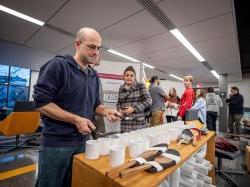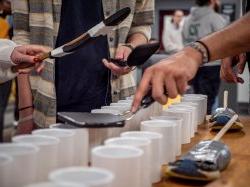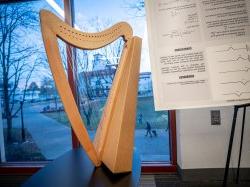Musical Numbers: Understanding How Math and Music Merge
In building a thongophone for mathematical analysis of its pipes for pitch, Montclair students find the connection between music and math

For anyone who believes math and music are an odd couple, 十大博彩推荐排名州立 大学 数学 Professor Bogdan Nita may have you changing your tune. Nita conducts 数学 and Music to teach students to see beyond formulas and to make connections by designing and building musical instruments to understand how musical elements can be analyzed numerically.
This semester, the class collaborated on studying a percussion instrument known as the thongophone. Built with recycled PVC pipes, the instrument produces a sound that varies according to the length of the pipes, one pipe per pitch arranged like the keyboard of a piano. It gets its name for the way it is played: The top of the pipes are struck with something flexible, like rubber thongs or flip-flops, the handiest things to use where the instrument originated in Australia and Papua New Guinea.
In building their own thongophone, the Math majors covered a wide variety of mathematical concepts – algebra, 几何, 微分方程, a bit of topology and vector calculus – and all of it related to music. “You talk about algebra and suddenly you talk about scales and then how can you invent your own scale? We do complicated algebra and the students can’t tell because they’re captivated by the music,妮塔说.


The instrument and student research were displayed at the Math and Music Showcase presented on November 29 by the Department of 数学. “We studied how sound is created inside the pipes because of pressure, the different ways you can create that pressure and how the length of the pipes relate to the pitch that is produced,Nita解释道. 我们写了方程, 我们解决了它们, we looked at thongophones that already exist and we built our own that’s sort of like a pipe organ you play with thongs.”
The 数学 and Music course was developed as part of a 大学 effort to connect math and the general sciences with different areas of creativity, 包括艺术, 体系结构, 诗歌, 绘画和音乐, 妮塔说. The initiative includes the launching in 2023 of the 激光杂志, 开放获取, 同行评议, online journal dedicated to research at the interface of mathematics and arts. The journal gets its name from the acronym L上墨 Art和 S科学通过 E教育和 Research.

数学 and Music has also contributed research on new and innovative harp shapes, with Nita and mathematics students Cristina Carr and Vlad Nita contributing to an article published in July in the Journal of Humanistic 数学. In their article, titled “The 数学 of the Harp: Modeling the Classical Instrument and Designing Futuristic Ones,” the research team shares how they analyzed and modeled the neck of the classical harp based on the length, tension and density of the strings.

特约撰稿人报道 玛丽莲·乔伊斯·莱伦. 照片 约翰J. LaRosa
你可能还会喜欢:
研究 team publishes article on the mathematics of a harp
